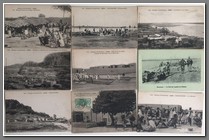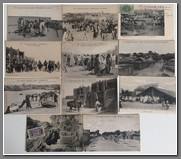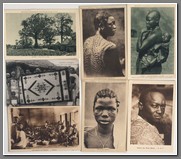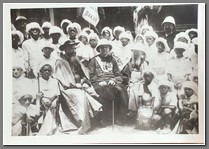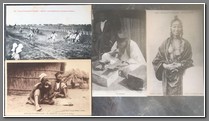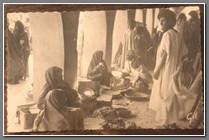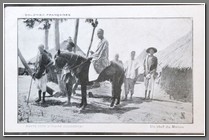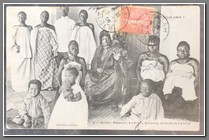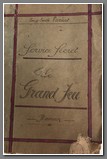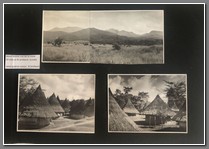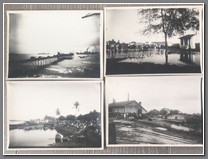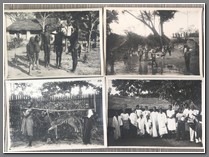French West Africa
Large photo of missionary activity in Senegal. The photo came from the archive of Giorgio Torchia. He was charged by the Vatican in the early 20th century with photographing Catholic missionary activity and the lives of local people around the world. These photos show colonial soldiers and indigenous warriors on parade in 1930.
Price: $40.00
Unpublished romance novel that takes place in Dakar, titled Service Secret Le Grand Feu, by Louis Emile Larant, 1939. 115 pages. Notebook in-12° (210 x 140 mm). manuscripts in brown ink. Handwritten cover.
Unpublished manuscript of this pleasant novel, written in a very readable hand and probably presented with the goal of being published. Illustrated manuscript title page.
Baron Louis de Saint Martin leads a double life: his trade in skins and salt between Kaolack and Dakar justifies neither his repeated absences, nor his fortune, nor his friendly relations with the “natives”; people talk about him and Europeans avoid him. Thus, when Saint Martin falls in love with Jacqueline Talvanac, he suffers from not being able to reveal his true identity to her.
We will especially remember an interesting painting of the colonial administration in Senegal. The novel, written in Montauban in 1939, is signed by Louis Émile Larant (Soissons: September 18, 1877 - Montauban: June 3, 1945), of the 1st Marine Regiment. Angular lack to the cover to the first leaves (rodent), hitch to the first flat cover, browned paper. B
Price: $290.00
Photo album belonging to famed scientific explorer Maxime Lamotte, of his geographical and fauna exploration of Mount Nimba, Cote d’Ivoire in 1942 as well as his return in 1946 and 1951 to study the ecological and bionomic research on the animal population of the Mount Nimba Strict Nature Reserve. 64 photos laid down and 93 loose, so 157 in total. Some photos of Dakar from 1946 included. The album speaks for itself, with high quality photos of local villages, camping and climbing Mount Nimba, market in Nzo, snake charmer, local Soussou chief and village, local habits, Malinke and Foula types. There is also a photo of him with Sekou Tourre in Conakry in 1981. Well captioned. B
Price: $3000.00
Note from Wikipedia: 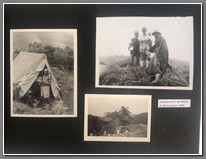 FA 266Maxime Lamotte, (1920-2007) was a French scientist , biologist , geneticist and pioneer in ecology . Through his studies of population genetics, he also became interested in evolution. His parents, Georges Lamotte, director at the prefecture of the Seine and Denise Huguet then lived in a pavilion with a garden, something rare in Paris and Maxime will always say that it was there that his vocation as a naturalist was born, observing the small beasts that populated this garden, a stone's throw from the Jardin des Plantes in Paris and the École Normale Supérieure . He entered the Lycée Henri-IV at the age of seven and remained there until Math-Elem in 1937. A very brilliant student, he accumulated prizes and entered the general competition. He hesitates between the École Polytechnique like his father, the National Agronomic Institute like his uncle, or the École Normale Supérieure. He chose the latter because he had just created a natural sciences section, corresponding to his tastes. He prepares for the competition at the Lycée Saint-Louis . Scouting also greatly influenced his life and as he would say later: “Africa did not scare me, I used to camp and the African bush particularly attracted me. According to Patrick Blandin: “Maxime Lamotte was, very young, a naturalist traveler, discoverer of species with sometimes astonishing biology in the high savannah of Mount Nimba, in Guinea. He was a pioneer in population genetics, with a thesis on natural populations of the wood snail Cepaea nemoralis . It gave a definite impetus to a fledgling French ecology. The study of the Lamto savannah in Côte d'Ivoire was one of the major international projects for analyzing the structure and functioning of terrestrial ecosystems.”
FA 266Maxime Lamotte, (1920-2007) was a French scientist , biologist , geneticist and pioneer in ecology . Through his studies of population genetics, he also became interested in evolution. His parents, Georges Lamotte, director at the prefecture of the Seine and Denise Huguet then lived in a pavilion with a garden, something rare in Paris and Maxime will always say that it was there that his vocation as a naturalist was born, observing the small beasts that populated this garden, a stone's throw from the Jardin des Plantes in Paris and the École Normale Supérieure . He entered the Lycée Henri-IV at the age of seven and remained there until Math-Elem in 1937. A very brilliant student, he accumulated prizes and entered the general competition. He hesitates between the École Polytechnique like his father, the National Agronomic Institute like his uncle, or the École Normale Supérieure. He chose the latter because he had just created a natural sciences section, corresponding to his tastes. He prepares for the competition at the Lycée Saint-Louis . Scouting also greatly influenced his life and as he would say later: “Africa did not scare me, I used to camp and the African bush particularly attracted me. According to Patrick Blandin: “Maxime Lamotte was, very young, a naturalist traveler, discoverer of species with sometimes astonishing biology in the high savannah of Mount Nimba, in Guinea. He was a pioneer in population genetics, with a thesis on natural populations of the wood snail Cepaea nemoralis . It gave a definite impetus to a fledgling French ecology. The study of the Lamto savannah in Côte d'Ivoire was one of the major international projects for analyzing the structure and functioning of terrestrial ecosystems.”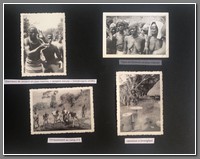 FA 266
FA 266
The discovery of Mount Nimba , the impression of power produced by this relief dominating the peneplain by more than 1,000 meters, deeply marked Maxime Lamotte as soon as he arrived in Guinea in 1942. In addition to his cartography work which will serve as a reference for Later research, Maxime Lamotte extended his exploration to the Simandou range whose geological formations are presented as a straightened monoclinal series. The comparative study carried out made it possible to highlight the coexistence of three types of relief in the quartzitic chains of Nimba and Simandou.
His geographical research also concerns the phenomena of hardening, presenting the results of years of prospecting in West Africa, and the cycles of erosion. From 1949, in collaboration with J-Ch. Leclerc and J. Richard-Molard, he identifies 4 cycles of erosion to which correspond 4 levels from 500 meters to 1,600 meters. A generalization to West Africa of the research carried out with G. Rougerie at Mount Nimba and at Simandou will enable him to subsequently propose a dating of these flattening levels.
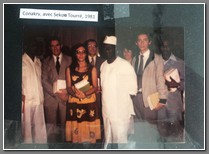 FA 266The signature of Maxime Lamotte finally appears in an important collective work devoted to the chain of Mount Nimba , alongside the three geographers who, through their conceptual research, will renew the image of Africa , and is presented as the best illustration of openness of his scientific thought.
FA 266The signature of Maxime Lamotte finally appears in an important collective work devoted to the chain of Mount Nimba , alongside the three geographers who, through their conceptual research, will renew the image of Africa , and is presented as the best illustration of openness of his scientific thought.
One of the main new species discovered by Maxime Lamotte is the viviparous toad Nectophrynoides occidentalis unique in the world. This has been the source of some fifteen theses. The work undertaken in Guinea will lead Maxime Lamotte to develop research in ecology much more than in evolutionary biology. His publications resulting from the missions relate in fact to the seasonal cycle of a tall grass savannah (1947), to the bionomic comparison of some herbaceous environments (1947), to the ecological cycle of the high-altitude savannah of Mount Nimba (1958), on the main features of its animal population (1962) and on its quantitative description. Maxime Lamotte and Jean-Luc Tournier created the Lamto station, an ecology research station, in order to deepen the studies undertaken at Nimba on the biocenoses and the functioning of savannah.
139 large format photos by photographer L. Mteyer (government photographer), at Grand-Bassam, Cote d’Ivoire. High quality photos showing Cote d’Ivoire in the 1920’s. Good mix of colonial and local images, particularly European factories in the interior. Most not captioned. B
Price: $2200.00

